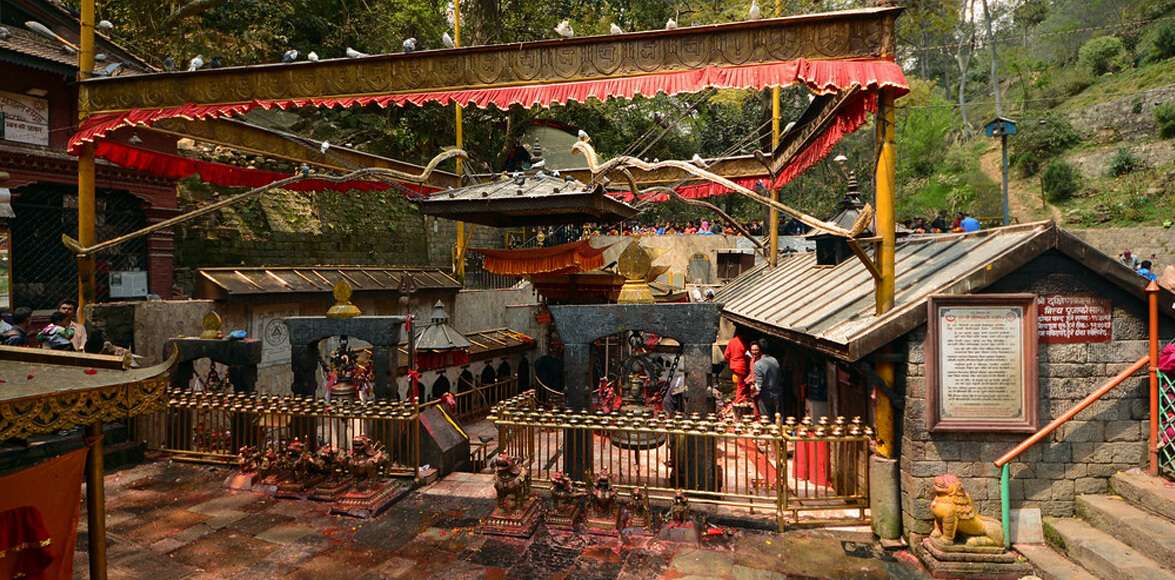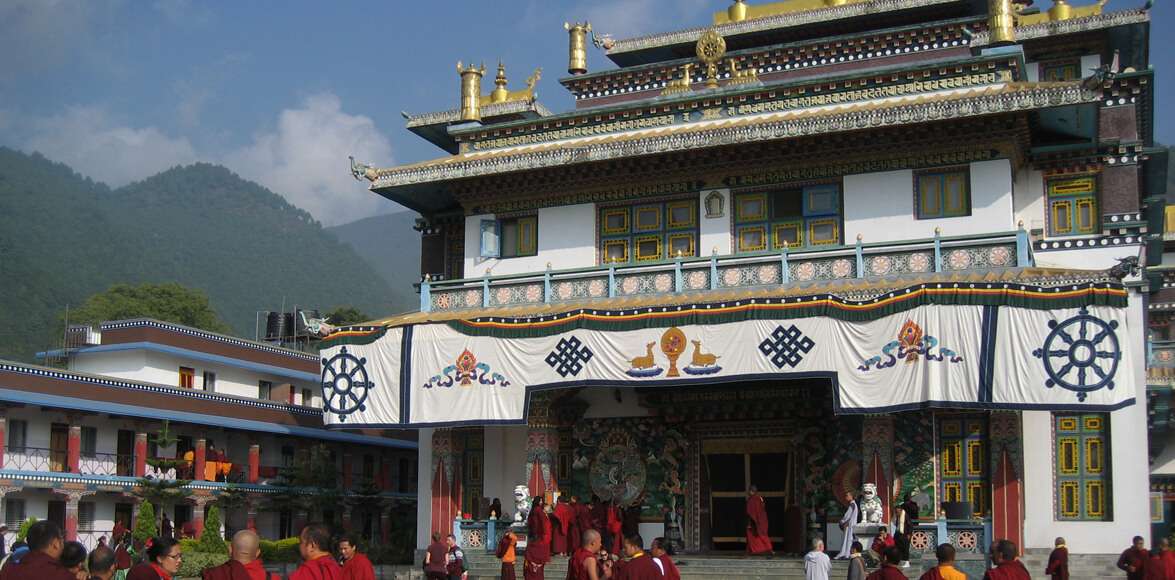Trip Overview
Pharping & Dakshinkali day tour is a perfect day tour in Kathmandu and best suited to those who want to explore Kathmandu and its cultural heritage. And, the tour includes a visit to a Hindu temple and Buddhist monastery.
The places to Visit on Pharping Dakshinkali Day Tour
Pharping Monastery – First places to Visit on Pharping & Dakshinkali Day Tour
- Pharping is a little, however, it is extending town around 23 km southwest of Kathmandu, on a slope over the principal valley. Pharping is referred to by the Tibetans as Yangleshö and once in a while as Phamting, as some state, it is the origin of the Phamtingpa, the heart-son of Naropa.
- Chatral Rinpoche clarifies that the 'Indian Phamting' (Tib. Rgya gar Pham thing) gets its name from the nearness of the extraordinary hood of the Naga ruler Lhakmachen or Shesha, which marks it as a site of his capacity. Accordingly to scholarly experts of the past used to call it Phanathingu (Tib. pha na thinggu), which signifies 'the nine hoods'. In the end, it was articulated Phamting. As a rule, the consecrated site of Yangleshö is alluding to the entire region of Pharping.
- Anyway, more explicitly, that it is alluding to two collapses, which Guru Rinpoche is said to have reflected. One is situated on the slope behind or more Pharping, usually known as Azura Cave or the 'Upper cavern of Yangleshö'. The other is found somewhat beneath Pharping, around a five-‐minute stroll outside of town, and known as 'Lower cavern of Yangleshö' or Yangleshö.
- Pharping has not exclusively been honored by Guru Rinpoche, it has been likewise visited by numerous extraordinary people, as long haul occupant Marpa Lotsawa, who rehearsed, made contributions, Ganachakra feasts, yearning petitions, etc.
- Padmasambhava, warmly called Guru Rinpoche by Tibetans, is the incredible holy person who is said to have gotten Buddhism the eighth century to Tibet, and built up and favored its first religious community called Samye. Even though there are numerous spots, Guru Rinpoche ventured out to, what makes Yangleshö a specific unique spot is, that Guru Rinpoche is said to have accomplished illumination here. In this way, Yangleshö is viewed as critical as Bodhgaya for experts of Tibetan Buddhism.
- From "A Great Treasure of Blessings" in the biography of Guru Rinpoche it says: "At that point at Yangleshö, present-day Pharping in Nepal, Padmasambhava rehearsed the sadhana of Yangdak Heruka with the partner Shakya Devi, a little girl of a lord of Nepal. Incredible spirits caused a three‐year dry season, with starvation and sickness, and Padmasambhava approached his educators in India for instruction to counter them. Two men returned, weighed down with the tantras and critiques of Vajrakilaya, and the minute they arrived, the snags were placated.
- Master Rinpoche and Shakyadevi both accomplished the third Vidyadhara level, 'Vidyadhara of the extraordinary seal, or Mahamudra'. Master Rinpoche perceived that Yangdak resembles a shipper participating in exchange ‐the accomplishment can be incredible, however so can the obstructions, while Vajrakilaya resembles an outfitted escort; he is expected to make preparations for impediments and defeat them. He at that point made sadhanas out of Yangdak and Vajrakilaya consolidated, and bound the watchmen of Vajrakilaya to ensure the lessons."
Things to see around Pharping Monastery
- Asura Cave: Asura cavern (Tib. Asure Trak Phuk) lies amid woods situated above Pharping town. Tulku Urgyen Rinpoche started rebuilding the collapse in the late 1980s and later established the religious community. After 3-year retreat focus currently known as Guru Drubne Pema Ösel Ling. The whole town of Pharping and the encompassing valleys are noticeable from the cloister, and on crisp mornings one can see Himalayan snow-capped pinnacles transcending in the far separation. The sun sparkles on the cave from morning to night and along these lines makes it a perfect spot for reflection amid the colder winter months.
- Hand Print: Different records are told about who set this imprint in strong shake outside the passage of the cave. A great many people concur that Guru Rinpoche did not make it. As indicated by one story, nearby trains and adherents of Samten Gyatso, Tulku Urgyen Rinpoche's root educator, made the imprint.
- Main Images: The three principal pictures cherished inside the cave are those of Guru Rinpoche in the center, Yangdak Heruka on his right side, and Vajrakilaya on the left side.
- Crack in the Ceilings: It is said that amid his stay at Asura Cave in the late 1980s, Jigme Phuntsok Rinpoche uncovered a term as a phurba from the roof of the cave, which is presently in the ownership of His Holiness the Dalai Lama.
- Small Tunnel: Tulku Urgyen Rinpoche clarifies that: "In the deepest openings of the Asura Cave is a passage that interfaces the Asura cavern to the Yangleshö Cave down beneath, about a large portion of a mile away. It's anything but a major gap. The wind goes through this entry and you can feel the draft when sitting close to it. Even though Padmasambhava could cross openly through the strong issue, he utilized this thin passage to move between Yangleshö Cave and the upper Asura Cave."
- Self-Arisen (“A”) – Syllable: It is found on the left half of the cave just underneath an electric knob that had been introduced in the stone.
- Vajrayogini Temple: It is said that Marpa Lotsawa visited this sanctuary absolute multiple times on his way from Tibet to India and back. Either finishing the primary road Pharping that drive towards the center of a town, to your correct side is a little street driving tough. The street will lead you to the second staircase paving the way to Asura cavern and starting to the Vajrayogini sanctuary. This is one of the four or five Vajrayogini sanctuaries of the Kathmandu valley. The others are situated in Sankhu, close to Swayambhunath, beneath the slope of Pashupatinath (Guhyeshwari), and in Chapagaun.
When you entered the fundamental entryway, the Vajrayogini statue is found on the main floor, following a little staircase to one side. The holy place is regularly shut, be that as it may, if the overseer is available the individual in question will open the holy place for you. It isn't permitted to take photos of the picture. On the off chance that you wish, you can offer some cash to the overseer, which will be utilized for contributions and upkeep. - Shesha Narayan Temple: Shesha Narayan temple is located between Chobhar and Dakshinkali, and the temple of Shesha Narayan represents one of the four Narayan's of the Kathmandu valley. The other three Narayan's are Changu Narayan of Bhaktapur, Visankhu Narayan of Patan, and Ichangu Narayan of Kathmandu.
Dakshinkali Temple – Second Place to visit on Pharping Dakshinkali Full - Day Tour
- Dakshinkali Temple is a standout amongst the most important sanctuaries in Nepal. It is one of the ancient, historic, and religious temples dedicated to one of the forms of Lord Shiva’s wife Goddess Kali “the goddess of time, death, and destruction. Dakshinkali means the goddess of the south where “Dakshin “stands for south direction. Kali is one of the incarnations of Goddess Parvati.
- Dakshinkali temple is located in the southwest part of the Kathmandu valley, which is nearly forty-five minutes’ drive by taxi from Kathmandu. The heaven and its encompassing are committed to goddess Kali, the deity who demands life two times a week, Tuesday and Saturday. So, a huge mass of devotees assembles particularly on Tuesdays and Saturdays where they for the most part sacrifice cocks and uncastrated male goats, as well as lots of animals, are forfeited during the holy festival of Dashain.
- By how seeing a thin path between mountains is pulled in and it is worthwhile to stroll down and over the old suspension connect, tossing a look down into the limited and profound hole. The view is only marvelous with all the green vegetables around, and the climate is simply excessively wonderful around there. In this spot, non-Hindus can't enter the building where the divinity as Kali is found. Pictures can be taken from outside.
- People can likewise make an excursion spot in this spot. Since, this spot is very far from the valley, there are less bustle, swarm, and different sorts of contamination. Individuals can likewise be getting a charge out of with loved ones in this spot. This spot is basic with greater amusement just as blessed spot. Individuals trust that if we implore the goddess and offer penance our foes will end, and we will be triumphs in our direction, and loads of other individuals to make their desires to the goddess. This spot is great on the off chance that you once visit you will always remember a lifetime.
History of Dakshinkali Temple
Legend says that once a Malla king dreamt of Goddess Kali, and she directed the king to construct a temple in a very strange and unknown spot. The king took it as a command and directed his men to start the construction immediately while constructing an individual said that, he had located a stone picture of goddess Kali in a similar spot where goddess Kali told the king to construct the temple. The picture was then left open with the components as she told over her head a pleated shade was kept erect with four brilliant snakes. Additionally, one can observe the pictures of ruler Ganesh, seven Asthamatrikas, and a stone Bhairav close by the pictures of the goddess.
Some Interesting Facts about Dakshinkali Temple
- Dakshinkali is well known as an excursion spot for local people. A climbing and a short trekking background in Dakshinkali is loved by the numerous voyagers resulting in these present circumstances place.
- Dakshinkali Temple is of extraordinary significance among the individuals who need her approval and among the favored ones. There is a firm trust in the potential of the goddess to make wishes work out as expected. Among thousands of guests, we can see sweethearts, businessperson, kids, understudies, work searchers, debilitated, and so forth.
- Here wishes are made before the goddess with the penance of creatures especially of cockerels and uncastrated male goats. On Tuesday and Saturday, and especially amid the celebration of Dashain, the yard of the sanctuary is secured with the blood of animals, and goddess Kali is washed with the blood.
Things to See in Dakshinkali Temple
- When you get to the parking parcel of the Dakshinkali sanctuary, it is a tad swarmed. The way at that point drives you down a shaded stone pathway lined by nearby individuals moving blossom and contributions for the Goddess, bison milk yogurt, and Khuwa (a dense milk sweet).
- Saturdays in Dakshinkali resemble merry sanctuary reasonable, with hordes of admirers wearing their best garments, tea slows down doing great business, and individuals hauling goats and chickens for the penance to the Goddess.
- Sanctuary is located down the trip of steps open to the sky and is beautified with the shelter of overlaid snakes. The dark stone picture of Kali demonstrates her crouching on a carcass, symbolizing triumph after some time. She holds other unnerving seals, for example, a skull container, a separated head, and a sword. At the edges are cherished pictures of Ganesh, the Ashta Matrika, and a plain stone Bhairab.


